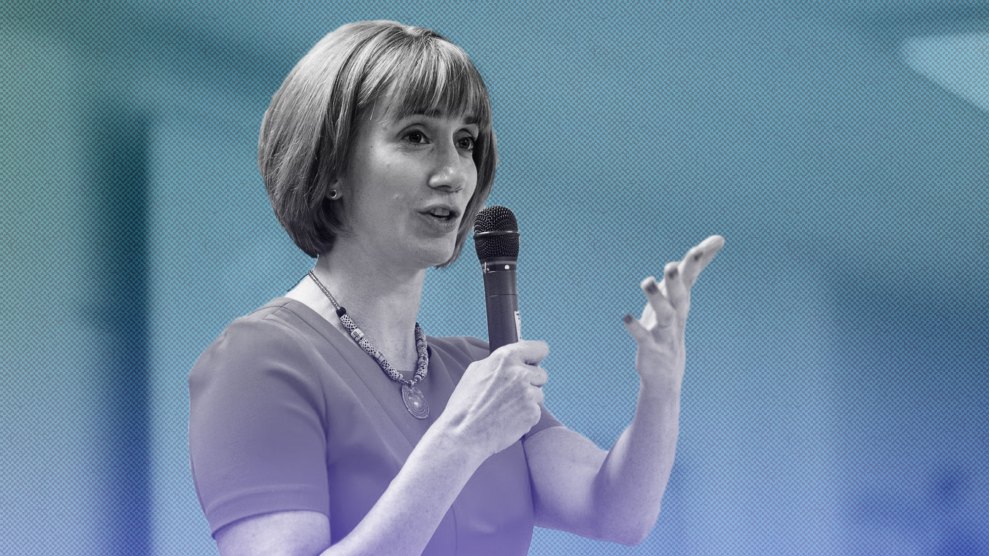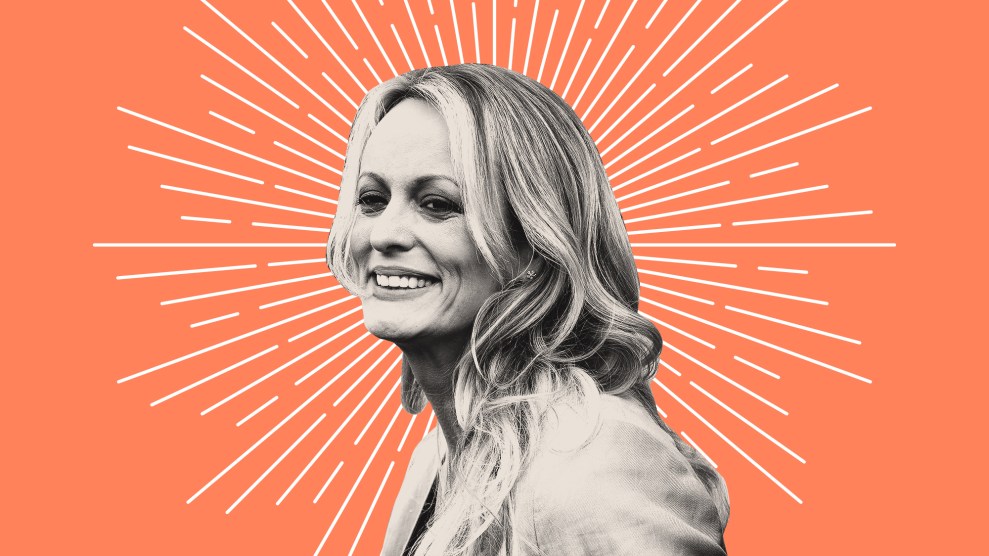If you were searching for the face of the capital-R Resistance, it would probably be someone like Laura Moser. A native of Houston, Moser moved to Chicago and then Washington, DC, when her husband took a job as a videographer for Barack Obama, but her own work steered away from politics. She wrote freelance articles about medical tourism, yoga, and fabric steamers for Slate and co-authored a series of Gossip Girl-inspired young-adult novels about a Texas teen who moves to Manhattan and falls in with a fast crowd; in one of the books, the protagonist ends up in a Jacuzzi in Trump Tower. Prior to the 2016 election, Moser explained in a recent essay for Vogue, “my sole claim to any kind of public recognition was being known as the mother in the viral photo from 2015 of a toddler throwing a tantrum at President Obama’s feet.” But now—like hundreds of thousands of other progressive women—politics has taken over her life.
After the election, Moser was outraged by the incoming Trump administration, but also overwhelmed by how much there was to be outraged about. What was needed, she thought, was a tool that would make activism routine. “Almost like hygiene,” she says. “You have to floss your teeth, you have to fight Donald Trump.” The result was Daily Action, a tool she launched in December that texts its 300,000 members once a day with instructions to call Congress about health care, Russia, or whatever else happens to be on the agenda. So far members have placed more than 1.1 million calls.* But Daily Action was only a gateway to deeper involvement. “You’re calling people all the time and if they’re not listening, who cares?” Moser says. “I want to change the people answering the phone.” So this spring she moved her family back to the Houston suburbs and decided to run for Congress in Texas’ 7th District against nine-term Republican Rep. John Culberson.
It turns out a lot of other people had the same idea. Texas Democrats may not have candidates for half the statewide offices on the ballot, but the Resistance has hit Houston hard. Seven candidates have signed up to run against the archconservative Culberson, whose seat has been in Republican hands ever since George H.W. Bush won it in 1966. Local chapters of new progressive organizations such as Indivisible are meeting weekly for house parties, phone banks, and canvassing sessions, and the Democratic Congressional Campaign Committee sent a full-time organizer to the district just a few months after Trump’s inauguration. Last fall, Culberson’s district swung harder toward Democrats than almost any other place in America: Trump lost by 1.4 percent after Mitt Romney had won by 21 points in 2012. Democrats believe that the 7th District and places like it—diverse, highly educated, and historically Republican—may hold the key to taking back the House. But to succeed, Democrats have to tackle the same problem they face across the country. They have to figure out what it is they want the Democratic Party to be.
In addition to Moser, the top competitors for the March primary are first-time candidates with stories that fit the political moment in different ways. Lizzie Fletcher, a well-connected lawyer at a large downtown firm, got her start in politics as a teenager during the 1992 Republican National Convention, when she volunteered to stand outside abortion clinics blocking Operation Rescue types from chaining themselves to the entrance. Alex Triantaphyllis, who at 33 is the youngest of the bunch, co-founded a mentoring nonprofit for refugees in Houston after spending time at Goldman Sachs and Harvard Law School. Jason Westin, an oncologist and researcher at Houston’s MD Anderson Cancer Center, told me he first thought about running a week after the election, after watching his daughter’s soccer game. She had taken a hard fall and Westin told her to “get back up and get back in the game”—but sitting on the couch later that day, scrolling through Facebook, he decided he was a hypocrite. He decided to enter the race with encouragement from 314 Action, a new political outfit that encourages candidates with scientific backgrounds to run for office. The primary is not until March, but in a sign of the enthusiasm in the district, Culberson’s would-be Democratic challengers have already held two candidate forums.
The 7th District starts just west of downtown Houston, in the upscale enclave of West University Place near Rice University, and stretches west and north through parts of the city and into the suburbs, in the shape of a wrench that has snapped at the handle. It had not given any indication of turning blue before last year. But a large number of voters cast ballots for both Hillary Clinton and Culberson. Moser and Fletcher see that as a sign that Republican women, in particular, are ready to jump ship for the right candidate. In the Texas Legislature, West University Place is represented by Republican Sarah Davis, whose district Clinton carried by 15 points, making it the bluest red seat in the state. Davis is an outlier in another way: She’s the lone pro-choice Republican in the state Legislature and was endorsed by Planned Parenthood Texas Votes in 2016. “To the outside world it looks like a huge swing,” Fletcher says of the November results, “but I think that a more moderate kind of centrist hue is in keeping with the district, so I’m not surprised that people voted for Hillary.”
But whether they’re Sarah Davis Democrats or Hillary Clinton Republicans at heart, those crossover voters still make up just a small percentage of the overall population. Houston is the most diverse metro area in the United States, and a majority of the district is non-white—a fact that’s not reflected in the Democratic candidate field. To win, Democrats will need to lock in their 2016 gains while also broadening their electorate substantially from what it usually is in a midterm election. That means making real inroads with black, Hispanic, and Asian American voters in the district, many of whom may be new to the area since the last round of redistricting. “[The] big thing in the district is getting Hispanic voters out, and nobody knows how to do that,” Moser acknowledges, summing up the problems of Texas Democrats. “If we knew how, we wouldn’t have Ted Cruz.”
Democrats’ play for the suburbs has mobilized candidates and organizers in places that haven’t seen much of either in years, but it has also amplified festering anxieties about what it takes to win them. The worst-case scenario in the eyes of some candidates is an assembly line of Jon Ossoffs, the millennial documentary filmmaker who, in an affluent, educated suburban Atlanta district this spring, spent a record $20 million on a campaign that emphasized technocratic platitudes and opposition to government waste at a time when Congress was moving to take health care from millions. Ossoff’s narrow loss affirmed that such districts were competitive and that Trump alone could help produce armies of volunteers in formerly crimson counties. But Ossoff had also, inescapably, lost.
At a recent candidate forum sponsored by a local Indivisible chapter, Westin, the oncologist, warned voters against repeating the mistakes of Georgia. “One of the take-home messages was that a giant pot of money is not alone enough to win,” he said. Westin’s message for Democrats was to go big or go home. While he believes the seven candidates are broadly on the same page in their economic vision and in their opposition to Trump, he urged the party to rally around something bold that it could offer the public if it took back power—in his case, single-payer health care. “We’re behind Luxembourg, we’re behind Malta, we’re behind Cyprus and Brunei and Slovenia in terms of our quality of health care,” Westin says. “That is astounding.” Who better to make the case for Medicare-for-all, he believes, than someone in the trenches at one of the world’s most prestigious clinics?
Moser, who likewise backs single-payer, may be even more outspoken about the need to change course. She argues that the Obama years should be a teachable moment for progressives. They let centrists and moderates like former Sens. Joe Lieberman and Max Baucus call the shots for a once-in-a-generation congressional majority, she says, and all they got was a lousy tea party landslide. “I don’t know if we would still have been swept in 2010—probably, because that’s the way it goes—but at least we could have accomplished some stuff in the meantime that we could claim now more forcefully and more proudly,” she says. A missed opportunity from those years she’d like to revisit is a second stimulus bill to rebuild infrastructure in places like Houston, where floods get worse and worse because of a climate Culberson denies is changing.
In Moser’s view, Democrats lose swing districts not because they’re too liberal but because they’re afraid to show it. When DCCC Chairman Ben Ray Luján, a congressman from New Mexico, told The Hill in August that the party would support pro-life Democratic candidates next November on a case-by-case basis (continuing a long-standing policy backed by Nancy Pelosi), Moser penned another article for Vogue condemning the position. “As a first-time Congressional candidate, I’ve been warned not to criticize Ben Ray Luján,” she wrote, but she couldn’t help it. Red states like Texas were not a justification for moderation; they were evidence of its failure. “I have one idea of how to get more Democratic women to polling stations: Stand up for them.”
Fletcher and Triantaphyllis have been more cautious in constructing their platforms. They’d like to keep Obamacare and fix what ails it, but they have, for now, stopped short of the single-player proposal endorsed by most of the House Democratic caucus. “I don’t think anyone has a silver bullet at this point,” Triantaphyllis says. Both emphasize “market-based” or “market-centered” economic policies and the need to win Republican voters with proposals on issues that cut across partisan lines, such as transportation. Houston commutes are notorious, and Culberson, Fletcher notes, has repeatedly blocked funding for new transit options.
Still, the field reflects a general leftward shift in the party over the last decade. All the major candidates oppose the Muslim ban, proposals to defund Planned Parenthood, and Trump’s immigration crackdown. Even in America’s fossil-fuel mecca, every candidate has argued in favor of a renewed commitment to fighting climate change. It is notable that Democratic candidates believe victory lies in loudly opposing the Republican president while defending Barack Obama in a historically Republican part of Texas. But Moser still worries her rivals will fall for the same old trap.
“I just think in this district people say, ‘Oh, but it’s kind of a conservative district,’ [and try] to really be safe and moderate, and I find that the opposite is true,” Moser says. “We just don’t have people showing up to vote. We don’t even know how many Democrats we have in this district because they don’t vote.”
Culberson has never been seriously targeted by the DCCC before, and he has twice run without any major-party opposition. In 2016, Clinton carried three Republican-held House districts, but the Texas Democratic Party, caught off guard by the swings, put organizers on the ground in only one of them, the 23rd, which includes parts of San Antonio. (Democrats didn’t even field a candidate in Rep. Pete Sessions’ Dallas-area suburban seat, which Clinton narrowly won.) If the 7th District doesn’t turn blue, this time at least it won’t be because no one paid attention. Activists from groups like Indivisible and Swing Left, two grassroots groups that sprang up after the election centered on autonomous local chapters, have also taken it upon themselves to begin doing the work Democrats have long neglected in the district, heading out uncertainly into their cul-de-sacs and apartment buildings to look for allies. On a muggy Saturday afternoon in May, I followed a pair of activists from Swing Left, Sarah Murphy and Rebecca Shukla, as they made their rounds in a suburban-style subdivision.
The kinds of activists—predominantly white women, in this case—who find themselves crowding into living rooms to discuss protests, phone banks, and knocking on strangers’ doors 18 months before the next election tend to have stories a bit like Moser’s. Murphy works for a chemical company and had never been involved in politics until this year, when she found herself listening to a lot of Pod Save America and looking for ways to break out of the “semi-throes of depression” induced by Trump’s election. Shukla is a bit older and has volunteered in the past for progressive organizations in Houston, but she found the process of volunteering wanting. Last year, she offered to drive Houston voters to the polls on Election Day, she told me, but no one in the local party responded.
The experience of going door to door to talk to their neighbors was a new one for both of them. Swing Left, through its network of small-dollar donors, has already raised nearly $112,000 for whichever candidate makes it out of the primary in the 7th, but it is not backing any of the Democrats until then—the district chapter’s focus right now is on fomenting discontent against Culberson. Unlike traditional campaigns and advocacy groups, Swing Left prefers to do its canvassing blind. When its members settle on a neighborhood (often near the home of one of the volunteers) they go up and down the blocks, stopping at every door. In the 7th, this work takes on a particular import because of the mystery surrounding the district itself. Years of Republican dominance compelled a lot of progressives to stay quiet about their allegiances—some were hesitant to even put up yard signs—and left little incentive for organizing. All the while, the flood of in-migration to the city and the county was continuously remaking the electorate. Democrats are just trying to find out who all these Democrats are.
Canvassing for political campaigns is mostly a series of missed connections—no one is ever home, or they are just too busy, or sometimes they are dead. Murphy and Shukla were upbeat as they made their rounds and eager to make their sell, but it can be easy to forget that most people are not as invested in an election that is still 16 months away, and that for all the energy at grassroots meetups, turning the energy of Resistance into a district-flipping force will take months, if not years, of work. At one house, a 20-something man in a Texas State T-shirt and basketball shorts answered the door. His parents were Republicans, but he had supported candidates from both parties, so the duo made their pitch. They rattled off their grievances with Culberson—he was inaccessible, he was lockstep with Trump, he had been in Washington for too long. Did the man know that there were seven candidates already signed up to run against him? Was he interested in hearing more at a later date? Would he consider volunteering?
Finally, the man looked up, a little confused. “When is the next election?”
*Correction: This article originally misstated the number of calls placed by Daily Action members.

















